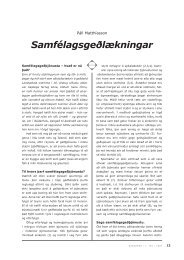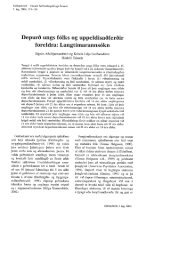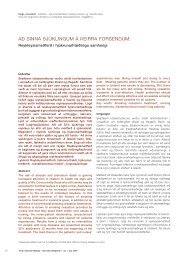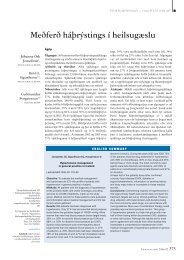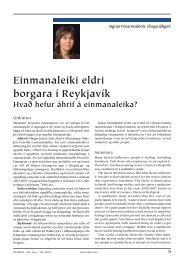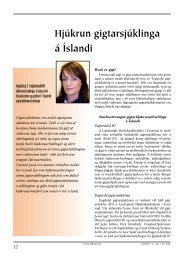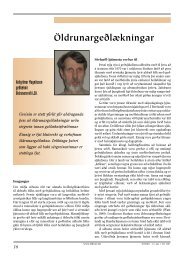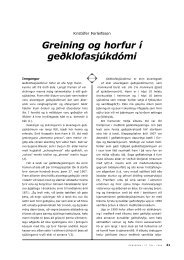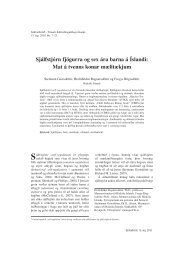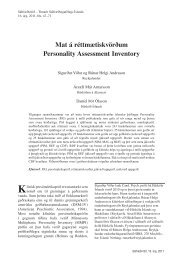Use of antimicrobials and carriage of penicillin-resistant ... - Hirsla
Use of antimicrobials and carriage of penicillin-resistant ... - Hirsla
Use of antimicrobials and carriage of penicillin-resistant ... - Hirsla
Create successful ePaper yourself
Turn your PDF publications into a flip-book with our unique Google optimized e-Paper software.
190 V. A. Arason et al.The incidence <strong>of</strong> respiratory tract infections mayvary between areas. There may also be a tendency tounder-diagnose AOM in some areas <strong>and</strong> overdiagnoseAOM in others. Furthermore, the variousareas may have different treatment traditions/culturesin relation to the clinical problem in question.A recent study by Gabbay <strong>and</strong> Le May addressed thephenomenon <strong>of</strong> varying clinical ‘‘mindlines’’ amongprimary health care practices in the UK [20].Parents in areas where antimicrobial drug usagewas lowest <strong>and</strong> broad-spectrum <strong>antimicrobials</strong>most rarely prescribed appeared to be better informedabout the benefits <strong>of</strong> restrictive use <strong>of</strong>antimicrobial drugs for upper respiratory tractinfections. These variations in parental attitudemay be important as primary care physicians maintainthat parental pressure <strong>and</strong> expectations inrelation to antimicrobial drug prescriptions representan important barrier to a restrictive prescribingpractice [2,21/27].Our results demonstrate an association betweenthe use <strong>of</strong> antibiotics, parental views about antimicrobialtreatment, <strong>and</strong> use <strong>of</strong> tympanostomy tubeplacements. However, it is impossible to say whetherthe associations between antimicrobial use for AOM<strong>and</strong> tympanostomy tube placements are due todirect causal effects or because <strong>of</strong> differences inmedical practice. The possibility <strong>of</strong> a direct positivecorrelation between antimicrobial drug (over) usefor AOM, future episodes <strong>of</strong> AOM, <strong>and</strong> tympanostomytube placement later warrants further investigation.AcknowledgementsThe authors would like to thank all the children <strong>and</strong>parents who participated in the study <strong>and</strong> the generalpractitioners who assisted in the study areas. Thisstudy was supported by the Icel<strong>and</strong>ic College <strong>of</strong>Family Physicians <strong>and</strong> the Research Fund <strong>of</strong> theUniversity <strong>of</strong> Icel<strong>and</strong>, Reykjavik.References[1] Arason VA, Kristinsson KG, Sigurdsson JA, GudmundssonS, Stefansdottir G, Mölstad S. Do <strong>antimicrobials</strong> increasethe <strong>carriage</strong> rate <strong>of</strong> <strong>penicillin</strong> <strong>resistant</strong> pneumococci inchildren? Cross sectional prevalence study. BMJ 1996;/313:/387/91.[2] Arason VA, Sigurdsson JA, Kristinssson KG, GudmundssonS. Tympanostomy tube placements, sociodemographicfactors <strong>and</strong> parental expectations for management <strong>of</strong>acute otitis media in Icel<strong>and</strong>. Pediatr Infect Dis J 2002;/21:/1110/5.[3] McCaig LF, Hughes JM. Trends in antimicrobial drugprescribing among <strong>of</strong>fice-based physicians in the UnitedStates. JAMA 1995;/273:/214/9.[4] Froom J, Culpepper L, Jacobs M, De Melker RA, Green LA,van Buchem L, et al. Antimicrobials for acute otitis media? Areview from the International Primary Care Network. BMJ1997;/315:/98/102.[5] Little P, Gould C, Williamson I, Moore M, Warner G,Dunleavey J. Pragmatic r<strong>and</strong>omised controlled trial <strong>of</strong> twoprescribing strategies for childhood acute otitis media. BMJ2001;/322:/336/42.[6] Damoiseaux R, Van Balen F, Hoes A, Verheij T, De MelkerR. Primary care based r<strong>and</strong>omised, double blind trial <strong>of</strong>amoxicillin versus placebo for acute otitis media in childrenaged under 2 years. BMJ 2000;/320:/350/4.[7] Rosenfeld RM, Vertrees JE, Carr J, Cipolle RJ, UdenDL, Giebink GS, et al. Clinical efficacy <strong>of</strong> antimicrobialdrugs for acute otitis media: metaanalysis <strong>of</strong> 5400children from thirty-three r<strong>and</strong>omized trials. J Pediatr1994;/124:/355/67.[8] Del Mar C, Glasziou P, Hayem M. Are antibiotics indicatedas initial treatment for children with acute otitis media? Ametaanalysis. BMJ 1997;/314:/1526/9.[9] Van Zuijlen DA, Schilder AG, Van Balen FA, Hoes AW.National differences in incidence <strong>of</strong> acute mastoiditis:relationship to prescribing patterns <strong>of</strong> antibiotics for acuteotitis media? Pediatr Infect Dis J 2001;/20:/140/4.[10] Levy SB. Multidrug resistance: a sign <strong>of</strong> the times. N Engl JMed 1998;/338:/1376 /8.[11] Molstad S. Reduction in antibiotic prescribing for respiratorytract infections is needed! Sc<strong>and</strong> J Prim Health Care2003;/21:/196/8.[12] Arason VA, Gunnlaugsson A, Sigurdsson JA, ErlendsdottirH, Gudmundsson S, Kristinsson KG. Clonal spread <strong>of</strong><strong>resistant</strong> pneumococci despite diminished antimicrobial use.Microb Drug Resist 2002;/8: /187/92.[13] Scottish Intercollegiate Guidelines Network (SIGN). Diagnosis<strong>and</strong> management <strong>of</strong> childhood otitis media in primarycare. A national clinical guideline. Edinburgh (Scotl<strong>and</strong>);February 2003, 18 p. (publication no. 66). Available at:http://www.sign.ac.uk/pdf/sign66.pdf[14] Franklin JH, Marck PA. Outcome analysis <strong>of</strong> childrenreceiving tympanostomy tubes. Otolaryngol 1998;/27:/293/7.[15] Paradise JL, Dollaghan CA, Campbell TF, Feldman HM,Bernard BS, Colborn DK, et al. Otitis media <strong>and</strong> tympanostomyinsertion during the first three years <strong>of</strong> life:developmental outcomes at the age <strong>of</strong> four years. Pediatrics2003;/112:/265/77.[16] Gates GA, Avery CA, Prihoda TJ, Cooper JC. Effectiveness<strong>of</strong> adenoidectomy <strong>and</strong> tympanostomy tubes in the treatment<strong>of</strong> chronic otitis media with effusion. N Engl J Med 1987;/317: /1444/51.[17] Schilder AGM, Rovers MM. International perspective onmanagement. In: Rosenfeld RM, Bluestone CD, editors.Evidence-based otitis media, 2nd ed. Hamilton: BC DeckerInc; 2003. p. 325/33.[18] Dagan R, Leibovitz E, Cheletz G, Leiberman A, Porat N.Antibiotic treatment in acute otitis media promotes superinfectionwith <strong>resistant</strong> Streptococcus pneumoniae carriedbefore initiation <strong>of</strong> treatment. J Infect Dis 2001;/183:/880/6.[19] Ah-Tye C, Paradise JL, Colborn DK. Otorrhea in youngchildren after tympanostomy-tube placement for persistentmiddle-ear effusion: prevalence, incidence, <strong>and</strong> duration.Pediatrics 2001;/107:/1251/8.[20] Gabbay J, le May A. Evidence based guidelines or collectivelyconstructed ‘‘mindlines?’’ Ethnographic study <strong>of</strong>knowledge management in primary care. BMJ 2004;/329:/1013 /6.



